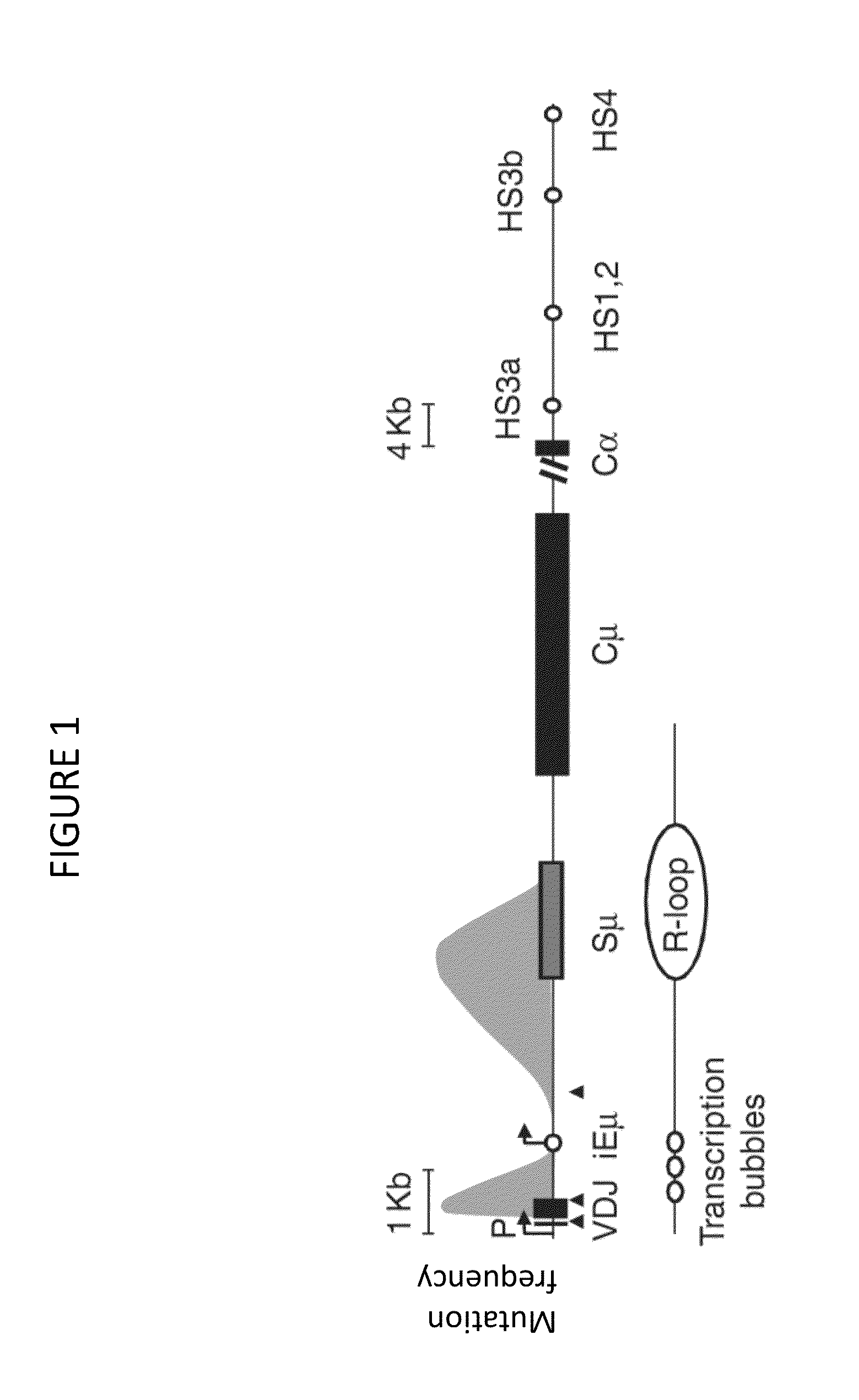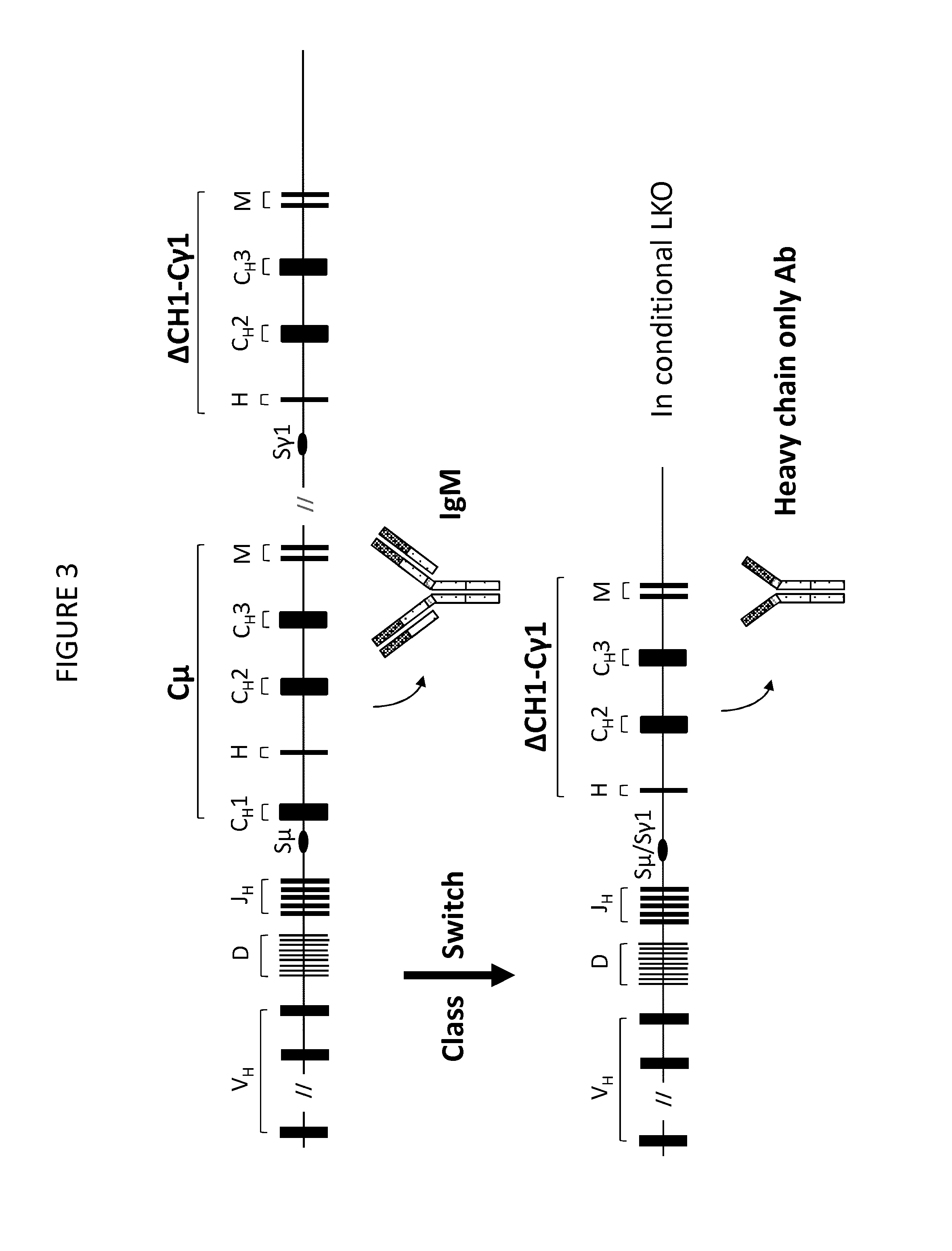Transgenic non-human vertebrate for the in vivo production of dual specificity immunoglobulins or hypermutated heavy chain only immunoglobulins
a technology of immunoglobulins and non-human vertebrate cells, which is applied in the field of transgenic non-human vertebrate for the in vivo production of dual specificity immunoglobulins or hypermutated heavy chain only immunoglobulins, can solve the problems of large b-cell compartments, low yield of desired combination of specificities, and limited utility for generating antibodies
- Summary
- Abstract
- Description
- Claims
- Application Information
AI Technical Summary
Benefits of technology
Problems solved by technology
Method used
Image
Examples
example 1
Improved Production of Heavy Chain-Only Antibodies
[0658]FIG. 3 is a schematic representation of an improved route to in vivo production of heavy chain-only antibodies in non-human vertebrates according to the invention. The figure shows the architecture of heavy chain loci in a transgenic vertebrate. Each heavy chain locus comprises a variable region comprising human VH, D and JH gene segments upstream of an endogenous (eg, mouse or rat) S-mu switch and an endogenous C-mu region comprising constant region gene segments (CH1, CH2, CH3, H (hinge) and M (membrane regions)). Downstream of this is a S-gamma switch (eg, an endogenous switch) and a gamma-1 constant region (eg, an endogenous gamma-1 constant region). The gamma constant region does not comprise a CH1 gene segment. Methods are known in the art for deleting gene segments, and specifically deleting CH1 (see, eg, Janssens 2006 mentioned above). For example, deletion by homologous recombination or RMCE can be effected in ES cell ...
example 2
Conditional Light Chain Expression
[0662]Conditional, or stage-specific, expression can be performed according to the invention during early stages of B-cell compartment and V repertoire development. As explained in Example 1, the invention provides for light chain expression to be switched off when isotype-switched (non-mu) heavy chains are being expressed.
[0663]FIGS. 4 and 5 show an example of how to engineer the genome of non-human vertebrates (mice in this example) to provide for such conditional light chain expression. Mouse chromosome 6 contains the activation induced cytidine deaminase (AICDA or AID) gene. This comprises 5 exons as shown by the solid boxes in the locus shown at the top of FIG. 4. UTRs are shown in open boxes at the 5′ and 3′ ends. AID is stage-specifically expressed in B-cells, and indeed is active when isotype-switched non-mu (eg, gamma) heavy chains are being expressed. The inventors have realised that this profile of expression can advantageously be harness...
example 3
Genetic Engineering of the IGγ1 Locus & Multivalent Heavy Chains and Antibodies
[0670]Reference is made to FIG. 6 which shows a schematic method for producing bi-specific heavy chains and antibodies as well as heavy chain loci in non-human vertebrate (eg, mouse or rat) genomes for producing these in vivo.
[0671]At the top of FIG. 6 is shown a heavy chain locus of the invention comprising (in 5′ to 3′ direction) an unrearranged variable region (comprising human VH, D and JH gene segments), endogenous S-mu, a mu constant region (comprising CH1, H, CH2, CH3 and M gene segments), an endogenous S-gamma-1 and a gamma-1 constant region. The latter comprises a nucleotide sequence (referred to as binding module, or BM) comprising linker and variable region binding domain nucleotide sequences, as well as gamma-1 H, CH2, CH3 and M gene segments. In this example, the BM encodes[0672]Linker (eg, (GGGGS)3)-VH, where VH is an antibody single variable domain (dAb) of known antigen-binding specificity...
PUM
 Login to View More
Login to View More Abstract
Description
Claims
Application Information
 Login to View More
Login to View More - R&D
- Intellectual Property
- Life Sciences
- Materials
- Tech Scout
- Unparalleled Data Quality
- Higher Quality Content
- 60% Fewer Hallucinations
Browse by: Latest US Patents, China's latest patents, Technical Efficacy Thesaurus, Application Domain, Technology Topic, Popular Technical Reports.
© 2025 PatSnap. All rights reserved.Legal|Privacy policy|Modern Slavery Act Transparency Statement|Sitemap|About US| Contact US: help@patsnap.com



